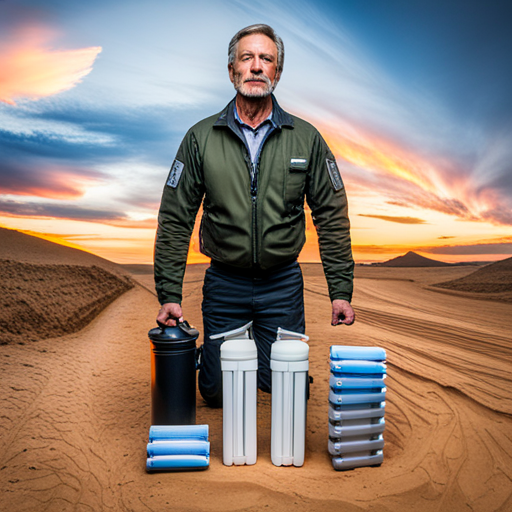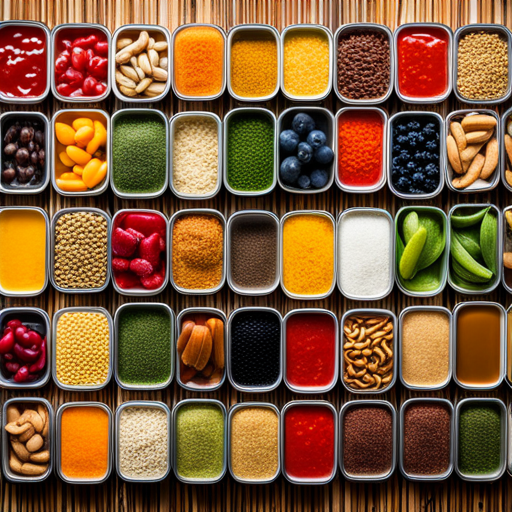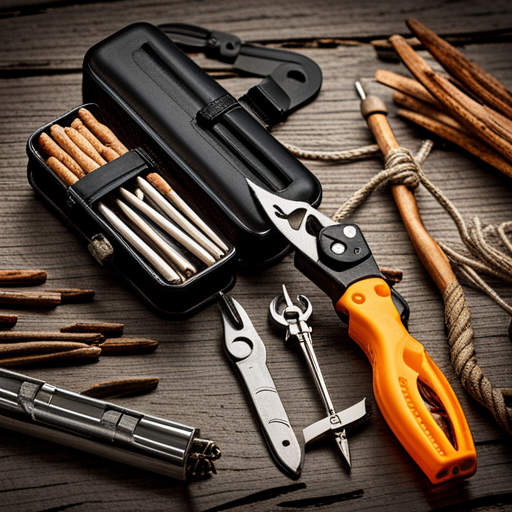As an Amazon Associate I earn from qualifying purchases.
Are you ready to take control of your own safety and well-being?
In this article, we will guide you through the essential items you need for your preparedness kit.
From water and food to shelter and first aid supplies, we’ll show you how to be self-sufficient and prepared for any situation.
Don’t wait for someone else to come to your rescue – it’s time to equip yourself with the tools and gear you need to thrive in a world that values freedom and self-reliance.
Key Takeaways
– Staying hydrated is crucial for survival, so include water filtration devices in your kit.
– Include non-perishable food items with a long shelf life in your kit and create a meal plan.
– Having a reliable shelter is important, so include emergency blankets and portable heaters.
– Include adhesive bandages and proper medical equipment for treating minor injuries and emergencies.
Water and Hydration

You’ll need to make sure you have enough water and hydration items in your preparedness kit. When it comes to survival, staying hydrated is crucial for your well-being and ability to navigate any situation. In order to maintain optimal hydration levels, it’s essential to have the right techniques and tools at your disposal.
One of the most important hydration techniques is to drink water regularly throughout the day. Aim to consume at least eight glasses of water daily, or more if you’re physically active. In addition to drinking water, you can also incorporate other hydrating beverages such as herbal tea or natural fruit juices.
However, in emergency situations, clean drinking water may not always be readily available. That’s why it’s vital to include water filtration devices in your preparedness kit. These devices can remove impurities and make water safe for consumption. There are various options available, including portable water filters, purification tablets, and UV sterilizers. Make sure to research and choose a filtration method that best suits your needs and preferences.
Food and Nutrition

Make sure to include non-perishable food items in your kit for sustenance and nutrition. When preparing for any emergency situation, having a reliable food storage plan is crucial.
Meal planning plays a vital role in ensuring you have enough food to last for an extended period. In times of uncertainty, having a well-stocked pantry can provide a sense of security and freedom.
When selecting food items for your emergency kit, focus on non-perishable options that have a long shelf life. Canned goods, dry goods such as rice and pasta, and dehydrated or freeze-dried meals are excellent choices. These items can provide you with essential nutrients and sustenance when fresh food is not readily available.
Meal planning is essential to make the most out of your food storage. Consider creating a menu that utilizes the items in your emergency kit efficiently. Plan balanced meals that include a variety of food groups to ensure you are getting the necessary nutrition. It is also wise to rotate your food supply regularly, using and replenishing items before they expire.
Having a well-thought-out food storage plan and meal planning strategy will not only provide you with sustenance during uncertain times but also give you the freedom to focus on other essential tasks without worrying about your next meal.
Shelter and Warmth

Having a reliable shelter is crucial for your safety and comfort during an emergency situation. When disaster strikes, you need to be prepared to protect yourself and your loved ones. That’s why it’s important to include essential items like emergency blankets and portable heaters in your preparedness kit.
Emergency blankets are lightweight and compact, making them easy to carry and store. They are designed to retain body heat and provide insulation in cold temperatures. These blankets are made from a reflective material that helps to trap heat, keeping you warm and comfortable. Whether you’re stranded in the wilderness or stuck in your home without power, having emergency blankets on hand can make a huge difference.
Portable heaters are another essential item for your shelter and warmth needs. These small devices can provide much-needed heat in chilly environments. Look for portable heaters that are easy to operate and have safety features such as automatic shut-off in case of overheating or tip-over protection. Make sure to keep extra fuel or batteries for your heater in your emergency kit.
First Aid and Medical Supplies

When it comes to being prepared for emergencies, having the right first aid supplies is crucial.
In this discussion, we will explore the top first aid must-haves that should be included in your emergency kit.
Additionally, we will also discuss the importance of having proper medical equipment on hand to effectively handle any medical emergencies that may arise.
Top First Aid Must-Haves
One of the top first aid must-haves for your preparedness kit is a pack of adhesive bandages. These small but mighty bandages are essential for treating minor cuts and scrapes that may occur during emergencies.
When it comes to first aid training and emergency response, having a reliable supply of adhesive bandages can make a significant difference in your ability to provide immediate care. Whether you’re out in the wilderness or facing a natural disaster, these bandages will help protect wounds and prevent infection.
With their easy application and secure hold, adhesive bandages ensure that your injuries stay covered and protected, allowing you to focus on other important tasks during an emergency.
So, don’t forget to stock up on adhesive bandages for your preparedness kit and be ready to handle any minor injuries that may arise.
Stay prepared, stay free.
Proper Medical Equipment
Make sure you stock up on the proper medical equipment for your emergency kit so that you are well-prepared to handle any medical situations that may arise. In times of crisis, having the right tools at your disposal can make all the difference.
Here are three essential items you should consider including:
– Tourniquet: A tourniquet can be a life-saving tool, especially in situations where severe bleeding occurs. Make sure you are familiar with its proper usage through medical training.
– CPR Mask: When performing CPR, a CPR mask provides a barrier between you and the person in need, reducing the risk of infection. It is a crucial tool for emergency response.
– Splint: A splint can stabilize fractures and prevent further injury. With proper medical training, you can effectively immobilize broken bones until medical help arrives.
Communication and Navigation

When it comes to communication and navigation during emergencies, it’s crucial to understand the differences between GPS and a compass.
While GPS technology provides accurate and real-time location data, a compass can be relied upon when GPS signals are unavailable or unreliable.
Additionally, two-way radios are essential for effective communication among group members, allowing for quick updates and coordination in times of crisis.
GPS Vs Compass
Using a GPS or a compass can help you navigate effectively in different outdoor situations. While both have their advantages and disadvantages, it’s important to consider what works best for you and your desire for freedom. Here’s a deeper meaning for you to ponder:
– GPS Advantages
– Real-time tracking: GPS allows you to know your exact location at any given time, giving you a sense of security and confidence.
– Convenience: With a GPS device, you can easily find your destination without the need for complex map reading or compass skills.
– Multiple functions: GPS devices offer features like altitude, speed, and distance tracking, making it a versatile tool for outdoor enthusiasts.
– Compass Disadvantages
– Reliance on external factors: Compasses require a clear view of the sky and a basic knowledge of map reading, making them less reliable in certain situations.
– Limited accuracy: Compasses may lead to errors due to magnetic variations or user mistakes, which can be frustrating when precision is crucial.
– Learning curve: Mastering the art of using a compass takes time and practice, making it less accessible for beginners or those seeking quick navigation solutions.
Two-Way Radios Essential
Having a two-way radio in your outdoor gear can greatly enhance communication and safety during your adventures. Whether you’re hiking in the mountains or camping in remote areas, a two-way radio allows you to stay connected with your group and call for help in case of emergencies. With a good radio range, you can communicate with others even when you’re miles apart. In emergency situations, quick and effective communication is crucial. A two-way radio provides a reliable means of emergency communication, ensuring that help can be summoned promptly. Choose the right two-way radio for your needs and enjoy the freedom of staying connected and safe during your outdoor adventures.
Tools and Survival Gear

It’s important to include tools and survival gear in your preparedness kit. When it comes to being self-sufficient and ready for any situation, having the right tools can make all the difference. Here are three essential items you should consider adding to your kit:
– Multi-tool: A versatile and compact tool that combines various functions, such as pliers, knives, screwdrivers, and more. It’s a must-have for any survivalist or outdoor enthusiast. Regular tools maintenance is crucial to ensure they are always in good working condition.
– Firestarter: Being able to start a fire is essential for warmth, cooking, and signaling for help. A reliable firestarter, like a ferro rod or waterproof matches, should be included in your kit. Remember to practice essential survival skills like fire-making techniques to ensure you can use your firestarter effectively.
– Emergency Shelter: A lightweight and portable shelter, such as a tarp or emergency blanket, can provide protection from the elements. It’s important to know how to set up a shelter properly and efficiently, as this skill can greatly increase your chances of survival in challenging situations.
Frequently Asked Questions
How Long Can Water Be Stored Before It Goes Bad?
You should know that water can be stored for a long time before it goes bad if you take precautions. Consider using water purification methods to ensure its freshness and safety.
Are There Any Alternative Sources of Food and Nutrition in Case the Provided Options Run Out?
If the provided options run out, there are alternative food sources you can rely on for emergency nutrition. Consider growing your own food, foraging for edible plants, or storing non-perishable items like canned goods.
What Are Some Effective Ways to Stay Warm Without Access to a Traditional Shelter?
When you’re outdoors and need to stay warm without a traditional shelter, there are several effective options. Look for natural shelters like caves or dense foliage, build a debris shelter, or use emergency blankets and sleeping bags for insulation.
Are There Any Essential First Aid Supplies That Should Be Included in Every Kit?
You should definitely include essential first aid supplies in your kit. Things like bandages, antiseptic, and pain relievers are crucial for handling injuries in emergency situations. Don’t forget to also include any necessary prescription medications or emergency medicine.
What Communication Methods Should Be Used in Case of a Power Outage or Loss of Cell Service?
When facing a power outage or loss of cell service, it’s important to have alternative communication methods. Consider using an emergency radio for updates during a power outage, and satellite phones or walkie talkies when cell service is down. Stay connected and informed.
Conclusion
In conclusion, having a well-stocked preparedness kit is crucial for any emergency situation.
You need to ensure you have enough water and food to sustain yourself, as well as proper shelter and warmth.
Having a first aid kit and medical supplies is essential for addressing any injuries or illnesses that may occur.
Additionally, communication and navigation tools are vital for staying connected and finding your way in unfamiliar territory.
Don’t forget to include survival gear and tools that can help you in various situations.
Stay prepared, stay safe!
As an Amazon Associate I earn from qualifying purchases.










